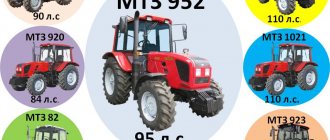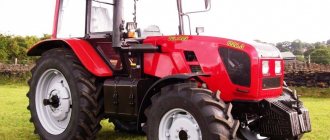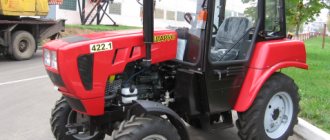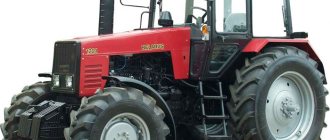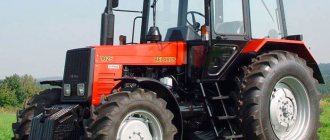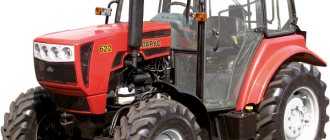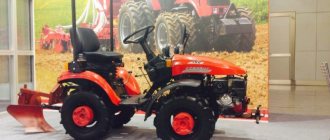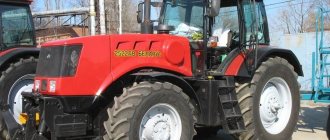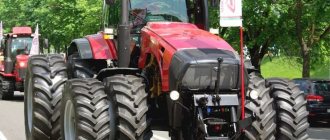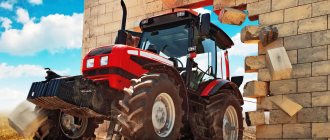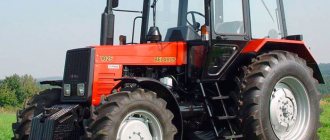The model of this universal row-crop machine was produced by the Minsk Tractor Plant in 1985, as an improved alternative to the parallel-produced MTZ 82(80), in order to increase the operational capabilities and productivity of agricultural units. MTZ 100 became the last brand of tractor of the Soviet period from the Minsk plant and subsequently did not receive similar mass production as MTZ 82. The tractor became the beginning of technical evolution for the subsequent production of a wide range of MTZ wheeled tractors, including energy-rich Belarus models - 3522, 3525, 3022.
Belarus MTZ 102
Place of production
MTZ-100 is a Belarusian brainchild in demand among consumers and is produced at a tractor plant located in Minsk. The unit has been produced since 1984 and is essentially a modernized analogue of the MTZ-80 tractor. A modern “weaving” is a combination of a powerful engine, a high-quality and reliable hydraulic system and optimal technical characteristics.
Reviews
“I have several different tractor machines, of which I highlight the MTZ-100. Every year I do maintenance at the company center, although I changed the rubber seals myself. Once the pump belt broke, but the specialists quickly fixed it. In summer it is very stuffy in the cabin, I would like to be refreshed by air from the air conditioner. In principle, an excellent representative of its class.” Vyacheslav Aleksandrovich, a farmer with 10 years of experience from Tver.
MTZ tractors are successfully used at agricultural enterprises, farms, and collective farms.
Purpose
MTZ-100 is one of the universal row-crop machines whose traction class is 1.4. The technical capabilities of the tractor make it possible to plow a wide variety of soil types, it processes almost all types of agricultural crops, transports goods and performs loading and unloading operations. Also, if necessary, you can easily install special attachments or trailed equipment on the machine. In particular, you can use: plows, cultivators, seeders, potato planters, transplanters, haystack throwers, hay haulers, etc.
Video MTZ 100
MTZ-100 is a product of the Minsk Tractor Plant and is used to perform a variety of agricultural work using trailed, semi-mounted and mounted machines and implements. again, the model is effective in combination with excavators, hole diggers, bulldozers and loaders when performing labor-intensive work. MTZ-100 has found its application as a drive for stationary machines for industrial or agricultural purposes, in transport, loading and unloading and harvesting operations.
This model is recommended for 1-19 zones of use.
MTZ-102 is a modified version of MTZ-100, distinguished by the presence of a front drive axle. The model is used to perform similar functions, but in more complex conditions.
Layout
The MTZ-100 cabin is located above the rear axle of the vehicle. The engine is installed on the front beam, and its reliable fixation is carried out using a hinge-type support. By the way, the power steering and radiators for the lubrication and cooling system are also located there. In general, the main elements of the tractor are:
- Half frame.
- Clutch housing.
- Bridge.
- Gear box.
In addition, it is technically possible to couple the tractor with a side power take-off shaft, a pre-heater or a drive pulley. Also, in order to ensure the required cross-country ability of the machine, it is quite possible to install the tractor on caterpillar tracks.
Steering components
A special feature of the MTZ 100 GORU system is that it is equipped with an ND-80K axial-piston type metering pump, which was subsequently replaced by a more reliable gerotor-type unit.
Metering pump ND 80K for hydrostatic steering MTZ 100
ND-80K is equipped with a safety valve set to maintain pressure up to 9.8 mPa (100 kgf/cm²) and two valves that soften shock loads set to 15.7 mPa (160 kgf/cm²). The pressure for the system is provided by a standard left-hand rotation gear pump NSh-10L. The pressure potential is provided by a hydraulic accumulator installed on the oil tank of the tractor hydraulic system.
Hydraulic cylinder and turning mechanism MTZ 100
As a power hydraulic unit, providing direct rotation of the steered front wheels, a two-piston hydraulic cylinder with a rear axle locking sensor was used, which in subsequent configurations of the power steering systems of MTZ tractors was replaced with a conventional double-acting hydraulic cylinder (ГЦ50Х25Х200 or reinforced ГЦ63Х30Х200). The design of the unit is a cylinder with two pistons connected to each other by a single rod, which, through its movement, interacts with the rotary shaft and bipod. When the steering wheel rotates, the dispenser supplies pressure to one of the above-piston cavities, corresponding to the direction of rotation; from the opposite cavity of the cylinder, oil is discharged into the drain.
Steering column MTZ 100
The position of the steering wheel is infinitely adjustable in height within 100 mm and in angle of inclination from 25° to 40° with an interval of 5°.
Engine Description
MTZ-100 has a four-stroke four-cylinder diesel engine D-245, equipped with turbocharging. The cylinders are arranged in a row. The engine capacity is 4.75 liters.
Thanks to the presence of a turbocharged compressor with adjustable pressure parameters, it is possible to obtain high torque in combination with very low crankshaft speeds.
The engine is driven by an electric starter. In frosty weather, starting the engine is simplified by turning on the pre-heater. Additional ease of starting is guaranteed by glow plugs and low-viscosity oil.
TDT-40
0
Source:
In the early 50s, the USSR Ministry of Forestry Industry stated that the KT-12A with its gas generator installation did not meet the increased requirements. Considering the disadvantages of the tractor, the ministry decided to abandon this machine altogether and raised the question of creating a new, more reliable skidder with a power of 60 hp instead. Having analyzed the situation, the designers and management of MTZ recognized the feasibility of creating a more powerful skidder, but also expressed the opinion that one powerful class of tractor for all zones in all forestry operations would be uneconomical. It was necessary to design a medium-power skidder that could be created on the basis of the KT-12A by installing a diesel engine of a Belarus wheeled tractor on it. In 1954, they developed the design of such a tractor, giving it the brand TDT-40. The tractor was intended for transporting logs directly from the cutting area. In addition to timber skidding, it was indispensable in logging and in all kinds of transport work in off-road conditions. Based on the results of operational tests in 1955, the interdepartmental commission stated that the TDT-40 tractor was very necessary for the USSR Ministry of Forestry Industry and it was advisable to establish its production in a short time. By decision of the USSR Ministry of Tractor and Agricultural Engineering, serial production of TDT-40 diesel tractors began at MTZ in May 1956. By the end of the year, their number reached 3,430. In the same year, design work was completed and the first experimental D-50 diesel engines for the promising tractor were manufactured. The new engine exceeded the power of its predecessor by 10 hp, was smaller in size and 350 kg lighter.
Driver's cabin
The characteristics of the MTZ-100 will be incomplete if we do not consider the driver’s workplace in as much detail as possible. The tractor cabin is designed for one person. Its frame is characterized by increased rigidity, which guarantees optimal protection for the operator in the event of an accident overturning the machine. The cabin is also equipped with an ejection air temperature control system, and additional comfort is ensured by the proper level of tightness.
The driver's seat is quite soft and can be adjusted, if desired, both vertically and horizontally. The corresponding mechanisms are located directly in front of the seat. For easy entry into the cabin, there are two steps, a safety handrail and a tilting steering wheel.
The engine hood is located on the outside of the radiator trim. A special latch securely secures it from unplanned opening. There are wings on the sides of the tractor, the purpose of which is to protect it from splashing. The traction qualities of the machine are increased due to the presence of auxiliary weights located on the front beam and a pair of rear wheels.
Hydraulic suspension system
The separate-unit hydraulic mounted system is equipped with a power and position regulator of mounted implements and a hydraulic additional loader for the tractor's adhesion weight.
The pressure in the system is created by a standard NSh-32 installed on the intermediate part of the transmission. Control is carried out by a three-section distributor P80-23R with a safety valve set to a pressure of 19.6 mPa (200 kgf/cm²). The rear linkage is equipped with a hydraulic power cylinder Ts125x200-24. The oil tank of the system, simultaneously with the supply of working fluid to the main hydraulics, provides the hydraulic steering system (HSS) of the tractor.
Conclusion
When creating the MTZ-100, the designers were guided by the goal of expanding functionality and ensuring the prospect of long-term mass production of the tractor. For implementation, a number of innovative, difficult-to-manufacture components were introduced into the machine systems. As a result, in fact, the tractor in its original configuration, despite all its operational advantages, was expensive and often caused difficulties in repair, especially in terms of the gearbox. Subsequently, the model was simplified and in the future it was produced only in the cotton modification MTZ-100X.
Options
MTZ-100, the technical characteristics of which are given below, is quite easy to operate and unpretentious in maintenance. The main technical data of the tractor are:
- Engine power – 100 horsepower.
- Specific fuel consumption is 242 g/kW per hour.
- The volume of the fuel tank is 156 liters.
- The hydraulic system has a lifting capacity of 30 kN.
- Agrotechnical clearance – 645 mm.
- The longitudinal base size is 2500 mm.
- The vehicle's own weight is 3750 kilograms.
- Height – 2790 mm.
- Length – 4120 mm.
- Width – 1970 mm.
- The track of the rear wheels can be adjusted within the range of 1400 – 2100 mm, for the front wheels this figure is 1250 – 1850 mm.
- Maximum travel speed is 35 km/h.
There is a modernized model MTZ-100 - 102. The new product has one significant difference from its predecessor, which is that the drive axle is the front one. This machine is designed to work in much more difficult conditions than its predecessor.
Characteristics of transmission components
The tractor has the same design as the MTZ 80(82): rear axle, front drive axle MTZ 102 and front non-drive axle MTZ 100, brake system, hydraulically controlled differential locking clutch, rear PTO drive with two-speed independent mode at 540 and 1000 rpm and synchronous drive 3.69 revolutions per meter of travel, planetary gearbox of the rear PTO.
MTZ 102 tractor diagram
Features of the rear axle
Some improvements have been made to the rear axle design without changing the overall design of the unit. So
- The right tapered bearing of the differential housing 7215 was replaced with 7515
- the design of the satellites and their support washers has been changed
- To replace the internal bearings 217 of the axle shafts, bearings 314 were installed
- axle shafts are hardened along the entire length
- a cast rear axle cover was installed, the axle sleeve housings were reinforced
The tractor rear axle locking operates in forced and automatic modes. The blocking sensor, which ensures the activation of the hydraulic clutch of the blocking shaft, is part of the HPS steering control.
Characteristics and functions of the gearbox
Upon request, two types of boxes with hydraulic couplings or synchronized ones were installed on the tractor. Both units have 80% unification of their components among themselves.
Gearbox with hydraulically controlled clutches
The unit ensures shifting of gears under load without interruption of the power flow under load and stepwise inclusion of ranges. Accordingly, the box consists of two parts: a gear shift reducer with fluid couplings and a range shift reducer with spur gears.
Gyrosystem of the MTZ 100 gearbox
Oil pressure in a separate hydraulic system of the gearbox is created by a gear pump NMSh-25. Two-level oil purification in a separate hydraulics of the box is carried out by a full-flow filter and a separate centrifuge. The flow of working fluid for gear shifting is controlled by a distributor built into the system.
Gearbox with hydraulic clutches MTZ 100
Box control
The gearbox provides continuously variable selection of four gears in one range using a lever with five positions. The first extreme rear position of the lever corresponds to the neutral position; moving the lever forward alternately engages the gears of the included range in four fixed positions.
Changing the range is carried out by switching the cylindrical gears of the second part of the gearbox when the power is interrupted by the clutch. The control lever has four sectors for switching ranges and two sectors for switching the “high-low” mode. Three sectors of the ranges provide the inclusion of six forward speed ranges and one sector – two rear speed ranges. Direct activation of the desired range is carried out by turning the handle and longitudinal movement of the lever relative to the tractor axis according to the diagram.
MTZ 100 gearbox range switching diagram
Thus, when the control lever first selects a lower mode, switching by sectors ensures the inclusion of 1,2,3 forward and 1st rear ranges, when selecting an increased mode - 4,5,6 forward and 2nd reverse. In general, its gearbox layout provides 24 forward gears in the speed range from 1.72 to 34.28 km/h and 8 reverse gears in the range from 3.09 to 16.19 km/h.
Synchronized gearbox
The gearbox with synchronized gearing has the same design, with the exception that gear synchronizers are installed instead of hydraulic clutches, ensuring the inclusion of rotation transmission to gear pairs with constant mesh. Switching the speed in the range is carried out by turning the handle around the axis and then tilting (rotating) the lever towards the selected gear according to the diagram. The procedure for selecting a range is similar to a gearbox with power shift with hydraulic clutches.
Drive for shifting gears and ranges of the synchronized gearbox MTZ 100
Also, a synchronized gearbox does not have a distributor, and the gearbox hydraulic system only performs the function of lubricating the rotating parts of the unit.
Scheme of a synchronized gearbox MTZ 100
Additional gearbox functions
A big advantage of the MTZ 102 is the front drive axle drive built into the gearbox, which eliminated the constant problems created by the intermediate support in the traditional version of the MTZ 82 FDA drive. The power flow is transmitted from the crown gear of the secondary shaft of the gearbox to the engagement mechanism and then through the cardan shaft directly to the main gear PVM transmission. The device consists of: a hydraulic pressing disc friction clutch controlled by a spool valve-distributor and a freewheel mechanism that ensures that the drive is turned on in automatic mode.
Front axle drive MTZ 102
For safety, a device that blocks the start of the diesel engine is installed in the gearbox range switching mechanism. The operation of the device is to cut off the power supply to the diesel starter when the range is on. Connecting the power supply is only possible when the rocker is in the neutral position.
